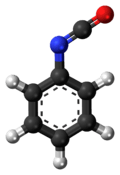Phenyl isocyanate
Phenyl isocyanate is an organic compound typically abbreviated PhNCO. The molecule consists of a phenyl ring attached to the isocyanate functional group. It is a colourless liquid that reacts with water. Phenyl isocyanate has a strong odor and tearing vapours, therefore it is therefore handled with care.
 | |
 | |
| Names | |
|---|---|
| Preferred IUPAC name
Isocyanatobenzene | |
| Identifiers | |
3D model (JSmol) |
|
| ChEBI | |
| ChemSpider | |
| ECHA InfoCard | 100.002.852 |
PubChem CID |
|
| UNII | |
CompTox Dashboard (EPA) |
|
| |
| |
| Properties | |
| C7H5NO | |
| Molar mass | 119.123 g·mol−1 |
| Appearance | Colourless liquid |
| Density | 1.09 |
| Melting point | -30 °C |
| Boiling point | 165 °C |
| Reacts with water | |
| -72.7·10−6 cm3/mol | |
Except where otherwise noted, data are given for materials in their standard state (at 25 °C [77 °F], 100 kPa). | |
| Infobox references | |
Characteristic of other isocyanates, it reacts with amines to give ureas.[1] Similarly, reacts with alcohols to form carbamates.
It is used in addition with triethylamine to activate nitro groups to undergo (C,O) 1,3-dipolar cycloaddition (as opposed to O,O). The nitro group (RCH2NO2) is converted to RCNO in the reaction, with CO2 as one of the by products.[2]
Structure
PhNCO is a planar molecule, according to X-ray crystallography. The N=C=O linkage is nearly linear. The C=N and C=O distances are respectively 1.195 and 1.173 Å.[3]
References
- Emmanuil I. Troyansky "Phenyl Isocyanate" in Encyclopedia of Reagents for Organic Synthesis, 2001 John Wiley & Sons doi:10.1002/047084289X.rp073
- Mukaiyama, Teruaki; Hoshino, Toshio (1960). "The Reactions of Primary Nitroparaffins with Isocyanates". Journal of the American Chemical Society. 82: 5339. doi:10.1021/ja01505a017.
- Marianne P. Byrn, Carol J. Curtis, Yu Hsiou, Saeed I. Khan, Philip A. Sawin, S. Kathleen Tendick, Aris Terzis, Charles E. Strouse (1993). "Porphyrin Sponges: Conservative of Host Structure in over 200 Porphyrin-Based Lattice Clathrates". J. Am. Chem. Soc. 115: 9480–9497. doi:10.1021/ja00074a013.CS1 maint: uses authors parameter (link)